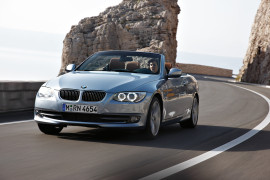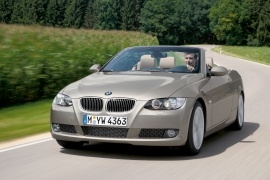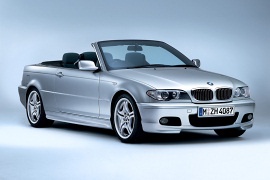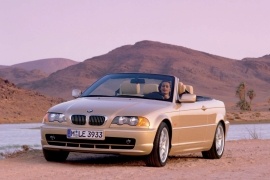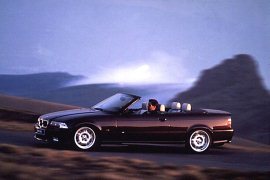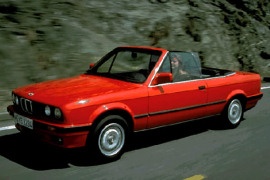BMW 3 Series Cabriolet Models/Series Timeline, Specifications & Photos
First production year: 1986
Engines: Gasoline, Diesel
Body style: Convertible (spider/spyder, cabrio/cabriolet, drop/open/soft top)
BMW waited another year after the introduction of the refreshed sedan and station wagon versions of the 3 Series before launching their updated convertible sibling, along with the coupe.
Creating a convertible with a retractable hard top wasn’t easy for the German automaker, especially if it wanted to pass as an appealing coupe. Furthermore, customers were obsessed with the vehicle’s structural rigidity, which meant that the car had to be significantly reinforced to provide a similar stiffness to the one provided by the fixed-roof version of the car. But BMW did it, even though it had to make it heavier. With the LCI, or Life Cycle Impulse as the automaker liked to name its facelifted models, the E93 gained more in the styling department, the technology package, and most importantly, under the hood. It shared many of its underpinnings with the rest of the 3 Series range, allowing customers to enjoy their fuel-efficient convertibles for over 1,000 km (620 miles) on a single tank, depending on the version.
Creating the same front fascia for the coupe as for the convertible was one of the ways automakers found to lower production costs, and the E93 was no exception. It featured the same clear lens headlights, available bi-xenon lights, and integrated LED turn signal lamps on the sides. Their swept-back design wasn’t changed compared to the non-facelifted version, but the kidney grille between them was new. Not only that it was flatter and wider, but it also sported a chromed rim. Furthermore, it featured chromed or black vertical slats, depending on the grade. Lower, on the bumper, the 2009 BMW 3 Series Convertible came with a redesigned apron featuring a broad opening adorned by two satin-silver slats mounted on the sides, flanking the lower air intake.
From its profile, the E93 kept its original shape, with its retractable hard top that looked like a regular greenhouse when covered. The automaker didn’t seem to put too much effort into restyling the car’s profile other than offering it new options for the light alloy wheels. At the back, on the other hand, it replaced the L-shaped taillights with ones that featured LEDs for the two light stripes of the turn signals lamps. In addition, the automaker introduced smaller reversing lights. Lower, the bumper featured one or two exhaust tips placed either on one or both sides, depending on the engine version.
Inside, the automaker introduced a fresh iDrive infotainment system, which was available as an option. It featured a list-style menu instead of the grid style as before. It boasted an 8.8-inch high-quality display installed in a separate cluster atop the center stack. The instrument panel had the same classic BMW styling, with large dials for the speedometer and the tachometer, which integrated the fuel level and the oil temperature, respectively. Thanks to the long wheelbase, there was enough room for the rear-seated passengers, even though the seat bench was moved forward to accommodate the storage space for the retractable hard top.
Under the hood, the automaker installed new, Euro 5-compatible engines that could be easily upgraded to the Euro 6 emission standards due to come into force in late 2014. In addition, the base model gained a few ponies, while the newly introduced 335is version came with 334 PS (321 hp). Unlike the rest of the range, the convertible wasn’t available with the all-wheel drive xDrive system.
BMW 3 Series Cabriolet (E93) 318i 6MT RWD (143 HP)
BMW 3 Series Cabriolet (E93) 320i 6AT RWD (170 HP)
BMW 3 Series Cabriolet (E93) 320i 6MT RWD (170 HP)
BMW 3 Series Cabriolet (E93) 325i 6AT RWD (218 HP)
BMW 3 Series Cabriolet (E93) 325i 6MT RWD (218 HP)
BMW 3 Series Cabriolet (E93) 330i 6AT RWD (272 HP)
BMW 3 Series Cabriolet (E93) 330i 6MT RWD (272 HP)
BMW 3 Series Cabriolet (E93) 335i 6MT RWD (306 HP)
The BMW E93 represents the cabriolet version of the best-sold model from the German automaker, the 3 Series. It is the last 3 Series model to come as a convertible, as the next generations of coupes and convertibles sell under the 4 Series name.
The innovation of the model comes from the fact that it is the first 3 Series to have a turbocharged gasoline engine under the hood. The most powerful version, the 335i, has a 3.0-liter straight-six engine paired with a twin-turbo that totals a power output of 306 hp (310 Ps).
For a more authentic feeling, the engine is complemented with a six-speed manual transmission that can optionally be upgraded to a seven-speed automatic transmission to provide smoother shifting for increased comfort.
The model marks not only the beginning of the turbocharged BMW era but also ends the natural aspiration period on BMW vehicles as it provides the last non-turbocharged engine of the brand.
One of the most distinctive features of the E93 is the retractable hardtop, as it represents the brand's first. The folding metal roof is preferred instead of the cloth roof to provide increased vehicle safety and show a complete look.
The redesigned lines of the BMW look good both with the top on and off, as the vehicle has a versatile character and looks immaculate in both states. To help the customers convince themselves that the car is equally beautiful, covered, or uncovered, the German automaker provides the "Comfort Access" feature that allows the driver to remotely lower or raise the roof through the car's key.
The Dark Burl Walnut wood trim is a standard feature for the BMW 3 Series Convertible. Customers can also select from Bamboo Anthracite wood, Light Burl Walnut wood, and Aluminum trims. These optional elements can be found on the dashboard, front and rear consoles, doors, and back side panels, just like the standard Dark Burl Walnut trim.
BMW holds the distinction of being the pioneer among car manufacturers in utilizing sun-reflective technology to combat high temperatures affecting various components such as leather seating, armrest surfaces, headrests, and the gear shifter. This innovative approach involves the incorporation of modified color pigments directly into the leather during the production process. By doing so, these pigments can reflect the sun's infrared radiation.
Through the application of this leather treatment, dark interior colors can experience a remarkable decrease in surface temperatures of up to 36 degrees Fahrenheit (20 degrees Celsius). Moreover, this treatment also delivers notable benefits for light-colored upholstery, where the impact of sunlight is less intense. In such cases, the treatment effectively reduces the surface temperature by an impressive 27 degrees Fahrenheit (15 degrees Celsius).
BMW 3 Series Cabriolet (E93) 320i 6AT RWD (170 HP)
BMW 3 Series Cabriolet (E93) 320i 6MT RWD (170 HP)
BMW 3 Series Cabriolet (E93) 325i 6AT RWD (218 HP)
BMW 3 Series Cabriolet (E93) 325i 6MT RWD (218 HP)
BMW 3 Series Cabriolet (E93) 330i 6AT RWD (272 HP)
BMW 3 Series Cabriolet (E93) 330i 6MT RWD (272 HP)
BMW 3 Series Cabriolet (E93) 335i 6AT RWD (306 HP)
After five years on the market, the fourth generation of the 3 Series, known as the E46, was ready for an update, and BMW refreshed it with a well-deserved facelift.
The German automaker didn’t want to follow the trend and call its updated models facelifted. Instead, it named them LCI (Life Cycle Impulse). In 2003, the 3 Series was the most important product of the German car manufacturer since it had the highest sales. Furthermore, the open-top version was essential since it had to compete against other significant premium vehicles, such as the Volvo C70 and the Mercedes-Benz CLK. Besides some aesthetical updates, the E46 Convertible LCI received new engines and improved cabins, making its customers feel better. In addition, there were new features available that had never been seen before on a 3 Series.
BMW knew that one of the things it had to change to make the car look fresh again was its headlights. As a result, it installed new ones featuring a single curved line on their lower outer sides instead of a double curvature as on the pre-facelifted version. That change also led to a redesigned front bumper that sported a broader lower air intake flanked by two scoops, which could be fitted with fog lamps. The main grille was surrounded by a chromed trim and was integrated into the hood.
From its profile, the 2003 BMW 3 Series Cabriolet (E46) had the same smooth lines with slightly flared wheel arches. Thanks to the longitudinally mounted engine, the entire nose of the vehicle was low, which led to improved visibility for the one behind the wheel. Since the car didn’t have any additional roll-over arches, the A-pillars that supported the panoramic windshield also played that role as a safety system. Behind them, there was nothing above the vehicle’s waistline, bar the seats’ seatbacks. As an option, the power retractable roof could be raised and lowered by pushing a button on the key fob. This was stored behind the cabin, in a designated area between the rear seats and the trunk, under a flip-up lid.
Inside, the automaker installed a redesigned dashboard and made more options available. Fronting the driver was a slightly redesigned instrument panel featuring the classic BMW dials. Unlike its predecessor, these featured flatter lower areas for the speedometer and tachometer. At the same time, the LCD below them showed data from the car’s onboard computer and the odometer. On the center stack, the car manufacturer offered an option for a sat-nav system, which was new for the 3 Series. The center console between the high-bolstered front seats housed the buttons for the power windows and the gear stick (or the gear selector, depending on the transmission). In the back, the bench seat was profiled for two and provided minimal legroom. As an option, customers could fit the vehicle with a net that played the role of a wind-stopper.
Under the hood, there was a new choice of gasoline and turbodiesel engines, with four or six cylinders. Depending on the options, these were paired with either a five-speed manual or automatic or a six-speed manual. Power went to the rear wheels only.
BMW 3 Series Cabriolet (E46) 318Ci 5AT RWD (143 HP)
BMW 3 Series Cabriolet (E46) 318Ci 5MT RWD (143 HP)
BMW 3 Series Cabriolet (E46) 320Ci 5AT RWD (170 HP)
BMW 3 Series Cabriolet (E46) 320Ci 5MT RWD (170 HP)
BMW 3 Series Cabriolet (E46) 325Ci 5AT RWD (192 HP)
BMW 3 Series Cabriolet (E46) 325Ci 5MT RWD (192 HP)
One year after the introduction of the 3 Series E46 Coupe, BMW released the drop-top version of this model and extended the lineup of its most successful nameplate to date.
After the release of the sedan and the station wagon versions, the most sought-after versions of the 3 Series, the German automaker continued the saga with the coupe and the convertible. While these were not the best-selling versions of the car, they represented BMW’s answer for those who wanted a vehicle more for the pleasure of driving rather than for their utility. However, there was one problem when creating a sports-oriented convertible. The car had to have a similar stiffness as the coupe from which it derived. BMW solved that with new reinforcements to the platform, but it did it even better than on the previous generation of the 3 Series convertible, the E36, which was considered stiff enough by customers. In fact, the automaker stated that it improved rigidity by 30% over that model, which was no small achievement by all means.
At the front, the vehicle penned by Erik Goplen carried over the same look as the E46 Coupe. Its headlights had a double curvature on their lower side and had the outer-mounted turn signals look like they were part of the entire assembly, even though they were not. Between them, integrated on the front side of the hood, BMW installed the famous kidney grille surrounded by a chromed trim and featuring slim vertical slats. At the same time, on the lower bumper, the car manufacturer placed a broad air intake that could integrate the available round fog lamps.
Ever since the first generation of the 3 Series Cabriolet, the E30, BMW has tried to create a sleek look for its convertibles. To achieve that, strong A-pillars were created to protect the occupants in the event of a rollover crash. For the E46 version, the automaker also installed pop-up roll bars behind the rear seats. These could deploy in 0.003 seconds if the vehicle was tilted on any side by 50 degrees. Other than that, there were no pillars besides those that sustained the windshield. In the back, the short and flat deck also sported an integrated third braking light. This system was carried over from the previous Cabriolet. As a novelty for the model, the car could be covered or uncovered remotely via the same buttons that locked or unlocked the car respectively.
Inside, the driver-oriented dashboard was typical for the E46 3 Series. The automaker placed the audio system at the top of the center console, followed by the HVAC buttons below. As standard, the 2000 BMW 3 Series Convertible came with a cassette player, while a CD changer was available. Furthermore, BMW also installed a navigation system, albeit without a big screen that could show a map. While that system wasn’t the best available, it could still lead the drivers to their desired destinations. In the back, the automaker had to push the bench seat slightly forward to make room for the retractable multi-layered canvas top. Surprisingly, the trunk was good enough since the ragtop and its mechanism didn’t take a big chunk of it.
Under the hood, the automaker installed a choice of gasoline engines ranging between 143 PS (141 hp) and a healthy three-liter inline-six powerplant that produced 231 PS (228 hp). All versions sent their power to the rear wheels only via a five-speed manual or a five-speed automatic.
BMW 3 Series Cabriolet (E46) 318Ci 5AT RWD (143 HP)
BMW 3 Series Cabriolet (E46) 318Ci 5MT RWD (143 HP)
BMW 3 Series Cabriolet (E46) 320Ci 5AT RWD (170 HP)
BMW 3 Series Cabriolet (E46) 320Ci 5MT RWD (170 HP)
BMW 3 Series Cabriolet (E46) 323Ci 5AT RWD (170 HP)
BMW 3 Series Cabriolet (E46) 323Ci 5MT RWD (170 HP)
BMW 3 Series Cabriolet (E46) 325Ci 5AT RWD (192 HP)
BMW 3 Series Cabriolet (E46) 325Ci 5MT RWD (192 HP)
BMW customers knew that an open-top version would follow to replace the former E30 Convertible, but the automaker made them wait until 1993, two years after the launch of the E36 lineup.
The German automaker didn’t want to rush things. After the sedan’s market launch in 1991, it took another year to finish and release the coupe on which the convertible was based. As a result, the rag-top was ready to meet its customers in 1993, just in time for the summer. BMW tried to create a vehicle that would look just as good with the top down as with the roof closed. Furthermore, the car manufacturer understood that the rear seats of the previous 3 Series, the E30, couldn’t provide enough legroom due to the short wheelbase and the rag top’s storage compartment. However, the new platform could provide enough to make four people feel comfortable even on long travels, regardless of whether the canvas top was up or down.
At the front, the design team, supervised by Claus Luthe, took as many parts as possible from the coupe version. The rectangular headlights continued on their outer corners with the turn signal lamps, which looked like extensions, even though they were separate parts. In addition, the wrapped-around plastic bumper featured a deeper chin, where the automaker installed the main air intake that cooled the engine. It was a significant design change since the upper grille had that role in the previous generation.
From its profile, BMW insisted that the car should perform well even if it didn’t have any sort of B- or C-posts to strengthen the bodywork, like the E30 Convertible. As a result, the engineering team worked relentlessly to develop a sturdy frame for the windshield, supported by thick A-pillars, which, despite being very raked, wouldn’t bend during a rollover crash. The result was a low-slung look, with an ascending line that started from the headlights and went across the bodywork all the way to the short rear deck. Depending on the version, the car also sported a set of aerodynamic side skirts, which made the car look even lower to the ground. Along with the 1993 BMW 3 Series Convertible, the German automaker introduced the power-retractable roof. The process was eased by the use of a single latching point instead of two, like on the E30. Out back, the trunk’s lid, even though it looked like it was borrowed from its coupe sibling, had an integrated third braking lamp, which was unavailable on any other E36 3 Series. At the same time, the corner-mounted taillights looked similar to those installed on its two-door sibling. Finally, the rear body-colored plastic bumper had a black lower valance with a cut on one side for the tailpipe, single or twin, depending on the engine version.
Inside, the automaker installed a set of bucket seats at the front with high bolstered areas that kept their occupants in place during hard cornering situations, while in the back, the rear bench seat provided enough comfort for average-sized passengers. But still, since the seating position had to be moved forward to make room for the canvas roof’s storage compartment, legroom was smaller than the one offered by the coupe version. BMW introduced an industry-first innovation for convertibles. While the car had a plastic rear window, it was also defrosted via a designated ventilation system placed between the rear passengers. To ensure their peace of mind, the automaker also installed pop-up rollover protections that could be deployed in 3 tenths of a second if the car’s tilt angle exceeded 50 degrees.
Under its beautiful skin, the E36 Convertible concealed a sturdy chassis that made the car feel and drive very similar to the coupe. Unfortunately, these reinforcements increased the overall weight, leading to lower performance. However, that wasn’t necessarily a significant problem for those who wanted a premium convertible for cruising. BMW offered the car with a choice of gasoline engines ranging from 115 PS (114 hp) to 193 PS (190 hp). Customers could opt for a five-speed manual or four-speed automatic transmission at the car's launch. Later, a five-speed auto became available across the range.
BMW 3 Series Cabriolet (E36) 318i 4AT RWD (115 HP)
BMW 3 Series Cabriolet (E36) 318i 5MT RWD (115 HP)
BMW 3 Series Cabriolet (E36) 320i 5AT RWD (150 HP)
BMW 3 Series Cabriolet (E36) 320i 5MT RWD (150 HP)
BMW 3 Series Cabriolet (E36) 325i 5AT RWD (192 HP)
BMW 3 Series Cabriolet (E36) 325i 5MT RWD (192 HP)
BMW dared to return on the convertible market in 1986 after about three decades since its last open-top vehicle left the assembly lines in Munich.
When the automaker launched the first generation of the 3 Series in 1975, it didn’t consider offering it as a convertible, and the same story went on with the second generation introduced in late 1982. Still, there was one particular coach manufacturer, Baur, who created an open-top version of the 3 Series (both generations), albeit the B- and C-pillars remained in place. Only the roof and the rear window could disappear from those versions. BMW noticed the customers’ interest in such body shapes and created one based on the 3 Series Coupe (E30), and unveiled it in 1986. Unlike the Baur top cabriolets, the factory-built convertible had no B- or C-posts. The only thing that raised above the vehicle’s waistline was the windshield.
BMW had to quickly adapt to the market’s demands, so it didn’t make any changes to the 3 Series Convertible's front. As a result, the car sported the same four-headlight system as the rest of the E30 range. Just like those, it featured a metallic bumper, which integrated the blinkers and the parking lights. Below, customers could opt for a pair of rectangular fog lamps, while an apron below them had reduced ground effect.
The absence of other pillars besides those supporting the windshield made the 1986 BMW 3 Series Convertible look even better. All exterior body panels but the doors were carried over from the 3 Series coupe, with just slight modifications for the rear fenders. The automaker offered the car with standard 14-inch alloy wheels with the same design as the other E30 models. For the folding roof, BMW used a spring-loaded mechanism that helped customers quickly unlatch it and store it behind the cabin. The only downturn of the car was that the rear window was made from plastic, not glass.
Inside, the E30 convertible shared its dashboard with its siblings. At the same time, the center console had two extra buttons for the rear power windows. Depending on the market, the automaker offered the car with standard sports seats covered with fabric or leather. In the back, the bench seat was profiled for two, and it could hardly accommodate average-sized occupants. BMW had to push the bench slightly forward compared to the coupe to make room for the rag top’s storage compartment. Accessing those seats was easy thanks to the tilt and move forward front seats, especially when the roof was retracted.
Under the hood, the convertible featured fuel-injected engines with four or six cylinders, depending on the market. These were paired with either five-speed row-your-own manuals or four-speed automatic. It was available exclusively as an RWD affair.
